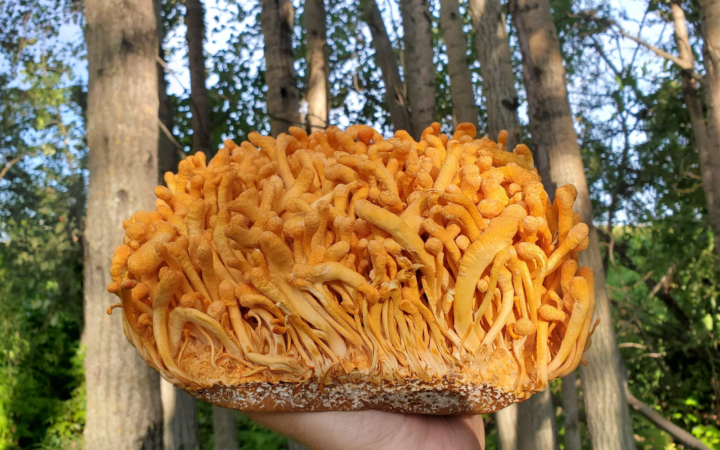What Are Cordyceps Mushrooms? This Guide Tells All!
Contents
- Getting to Know Cordyceps Mushroom
- Types of Cordyceps
- How are Cordyceps Mushrooms Grown?
- How Cordyceps Works (It's Scientific!)
- What Are the Benefits of Cordyceps Mushroom?
- Choosing the Best Cordyceps Mushroom Supplement
- How to Take Cordyceps Mushroom Supplements
- Cordyceps Mushroom Side Effects to Know
- Can You Eat Cordyceps?
- Cordyceps For the Win!
Cordyceps is a unique mushroom prized for its positive effects on energy, immunity, lung health and exercise performance*.
Everything about cordyceps mushroom sets it apart from its fellow medicinal fungi—from the way it grows to its anecdotal fame as an athletic performance enhancer.
But is any of the cordyceps lore true?
Well, we can tell you right off that it isn’t a worm (although worms may be involved; more on that later), but the rest requires a little more detail. Take a deep dive into this guide to discover the history and benefits of cordyceps and how to use it to boost health.
Getting to Know Cordyceps Mushroom
The name “cordyceps” comes from Latin and means “club head,” which is an appropriate description.[1]
But around the world, it’s known by plenty of other names like:
- Caterpillar fungus (in English)
- Dong Chong Xia Cao (China)
- Tochukas (Japan)
- Yarza gunbu (Tibet)
- Hsia Ts’Ao Tung Ch’Ung
- Yarsa gumba
- Champignon chenille
- Vegetable caterpillar
So far, over 700 species of cordyceps mushrooms have been identified, most of which originate in Asian countries. Two in particular—Cordyceps sinensis and Cordyceps militaris—are highlighted for their medicinal properties; others are being investigated for potential benefits.
Translating the Chinese and Tibetan names for cordyceps hints at a unique characteristic of the mushroom: “winter worm, summer grass” and “summer grass, winter bug.”
Another designation in Chinese medicine, chon cao or “insect plant,” points to the rather bizarre origins of O. sinensis.[2] (Hint: This is where the worms come in.)
What Does Cordyceps Look Like?

As the name suggests, cordyceps mushrooms grow in long, spindly shapes with a small “club” at the top. They can be brown or bright orange in color and are fairly strange-looking as far as mushrooms go.
The stalks of cordyceps are called the “stroma” and are sometimes listed this way on cordyceps supplements instead of “fruiting body,” which is the more common term.
Types of Cordyceps
Cordyceps mushroom supplements are made from either C. sinensis or C. militaris. Although often used interchangeably in traditional Chinese medicine, the two have different origins and have been studied separately for their medicinal qualities.
Cordyceps sinensis
The rarest and most expensive of all cordyceps mushrooms, wild C. sinensis is never found in supplements but may be purchased in its whole form in some Asian countries. This species grows to be between 4 centimeters and 10 centimeters (about 1.5 to 4 inches) and can have a yellowish color when fresh, which deepens to brown or black as the mushroom dries out.
It’s interesting to note that this ancient mushroom had a bit of an identity change in 2007. Some scientists performed what’s called a phylogenic analysis, in which sequences of genetic nucleotides and amino acid are analyzed along with structural features of proteins to determine genetic relationships.[3]
This deep dive revealed *Cordyceps sinensis—*as it was then called—lacks a close relationship to the majority of other cordyceps varieties, so the mushroom was reclassified as Ophiocordyceps sinensis. However, for all practical purposes we can just call it Cordyceps sinensis. (Latin names are tough enough!)
Cordyceps Militaris
Sometimes called the “cordyceps flower,” Cordyceps militaris does produce a fruiting body—and it’s pretty easy to cultivate on a large scale.
This variety of cordyceps is bright orange and bears a striking resemblance to Cheetos. The stroma can grow to be between 20 millimeters to 50 millimeters (about 3/4 of an inch to 2 inches) tall and may contain higher amounts of beneficial compounds than Cs-4.
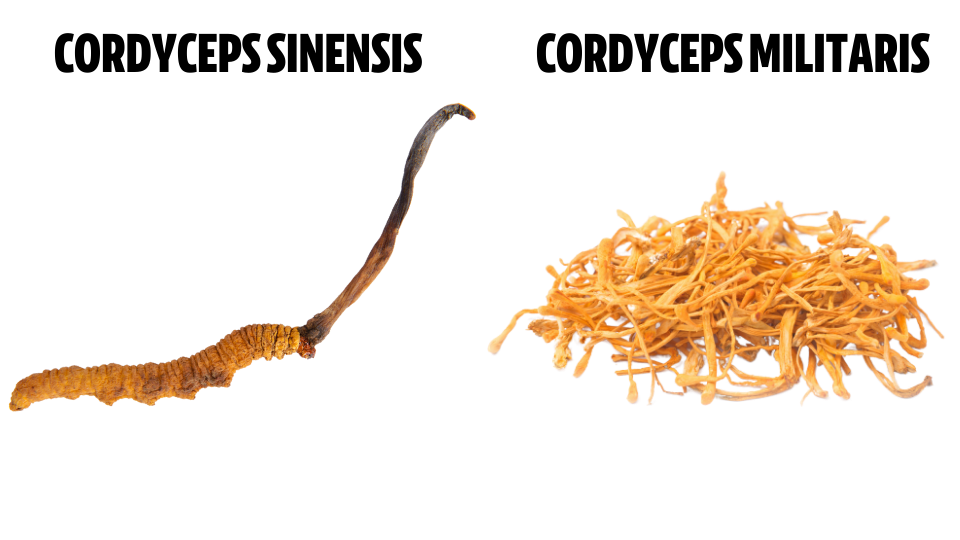
WHAT ABOUT CS-4?
Cs-4 (which stands for Cordyceps sinensis 4) is a strain of Cordyceps that is cultivated in liquid fermentation. If you see “sinensis” sold in a medicinal mushroom product, this is likely what is inside.
Because Cs-4 is only capable of producing mycelium, it’s known as an anamorph: a vegetative or “asexual” form of the mushroom that doesn’t generate spores.
There’s actually a bit of a debate over whether Cs-4 is even a “true” anamorph of C. sinensis. Although other strains, particularly Hirsutella sinensis, show a greater genetic similarity to cordyceps, Cs-4 is still the most-used strain and is likely the source in the majority of supplements listing Cordyceps sinensis on the label.[4]
More research needs to be done to determine if other known and potential anamorphs have the same medicinal properties and beneficial compounds as Cs-4, or if Cs-4 itself is anywhere near as beneficial as other strains of Corydceps.
How are Cordyceps Mushrooms Grown?
Growing cordyceps is a bit different than growing other medicinal mushrooms. Cultivation—either as Cs-4 or Cordyceps militaris— is the preferred method; in fact, almost no cordyceps supplements contain wild-grown mushrooms.
Why?
The answer is more than a little weird…
Cordyceps in the Wild: The Parasite Factor
Most mushrooms grow on dying trees or decaying matter. But not C. sinensis.
It prefers to grow on insects.
Yes, insects.
It’s called being an endoparasitoid or entomopathogenic fungus, and its hosts are mainly anthropods—bugs and other invertebrates with exoskeletons.
Ghost moth larvae (Hepialus armoricanus) are the most common hosts. When cordyceps spores infect a ghost moth caterpillar, they essentially take over its body, using the internal tissues as fuel. When the caterpillar dies, and the cordyceps stroma grows out of its head.[5]
The textured surface on the club of the stroma releases spores, which are distributed into the surrounding environment to colonize new larval hosts.
Wild cordyceps are mostly found at higher elevations—between 3,500 and 5,000 meters (about 11,500 to 16,400 feet)—which makes the Himalayan mountains a popular harvesting spot.
Due to the relative rarity of C. sinensis in the wild and concerns about overharvesting, researchers are looking into the possibility of replicating the mushroom’s parasitic lifestyle for large-scale cultivation—but there’s an easier way to go about growing cordyceps for supplements.
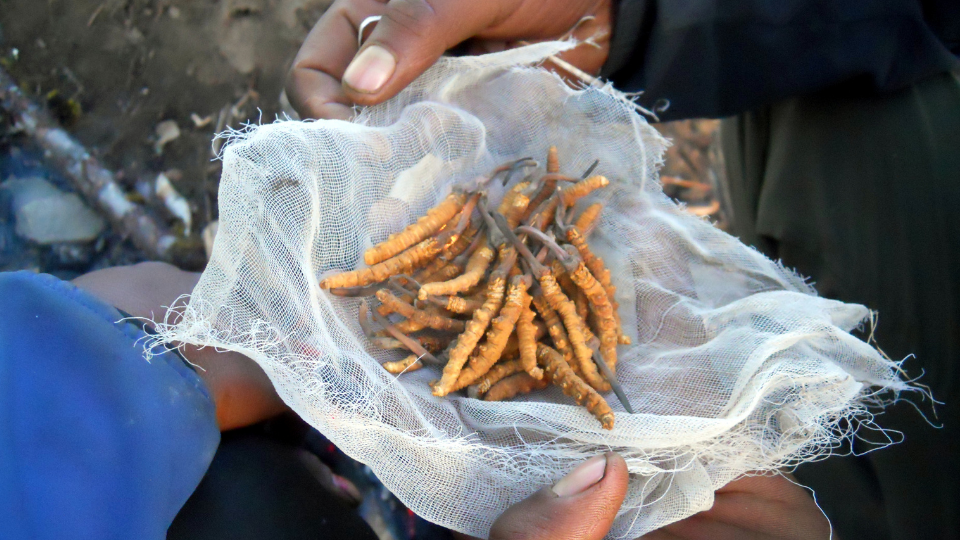
Wild harvested Cordyceps sinensis. (Can you see the worm?)
Cordyceps Mycelium in Liquid Culture
Interestingly, cordyceps is one mushroom whose cultivated mycelium appears to have some benefits that are similar to the wild harvested variety.
The most common way of achieving mycelial growth on a large scale is in a liquid culture. This method is often used in China, where the Cs-4 cordyceps anamorph is grown in giant fermentation tanks.
The sterilized liquid culture contains all the nutrients the mycelium needs to grow, and strands of mycelium suspended in the culture expand at a rapid pace.
When it can’t grow anymore, the mycelial mass is removed from the tank, dried and pulverized into powder. Some of the active compounds produced outside the mycelial cells, known as extracellular compounds, may be lost when the spent culture broth is discarded, but concentrations in the mycelium are still very close to those in wild-harvested C. sinensis.
Growing Cordyceps Fruiting Bodies
Cordyceps militaris is grown a different way: on solid substrates.
In this process, soy or rice is sterilized and placed in growing containers like jars or plastic bags before being inoculated with cordyceps mycelium. A filter is added to prevent contamination as the mushrooms grow slowly at low temperatures.
Growing cordyceps this way increases the concentration of beneficial compounds.
It takes about a month to get a C. militaris harvest, the final product of which is the full fruiting bodies that appear in the majority of cordyceps supplements.

A Cordyceps militaris mushroom farm.

Cordyceps militaris fruiting bodies almost ready for harvest.
Cordyceps Mycelium on Grain
The third option for cultivating cordyceps for supplements is to grow mycelium on grains like rice, wheat or rye. Unlike cultivating fruiting bodies, this method results in a mass of mycelium that’s also full of substrate.
Some evidence suggests using this method can capture some of the extracellular compounds lost in liquid culture cultivation and that grain-grown products may have higher levels of compounds like cordycepin when compared to Cs-4.
However, a great deal of grain gets mixed in when the mycelium is harvested and processed, so the ratios of beneficial compounds are likely to be lower overall.
Ants: True Cordyceps Mushroom “Zombies?”
One last thing of note: Bullet ants can also get “taken over” by cordyceps. But it’s a different species—Ophiocordyceps unlateralis.
Once the spores enter the ant’s bodies, the insects climb up stems or branches and cling there. The cordyceps then grows out of the ant’s head, which can take up to three weeks. (You can watch the process here, but be warned—it’s a little gross.)
This isn’t as unique or bizarre as it may seem. Each type of wild cordyceps uses a specific species of insect to reproduce. But cordyceps can’t make the jump to humans (no matter what video game creators may have you believe).
Cordyceps as Medicine in History
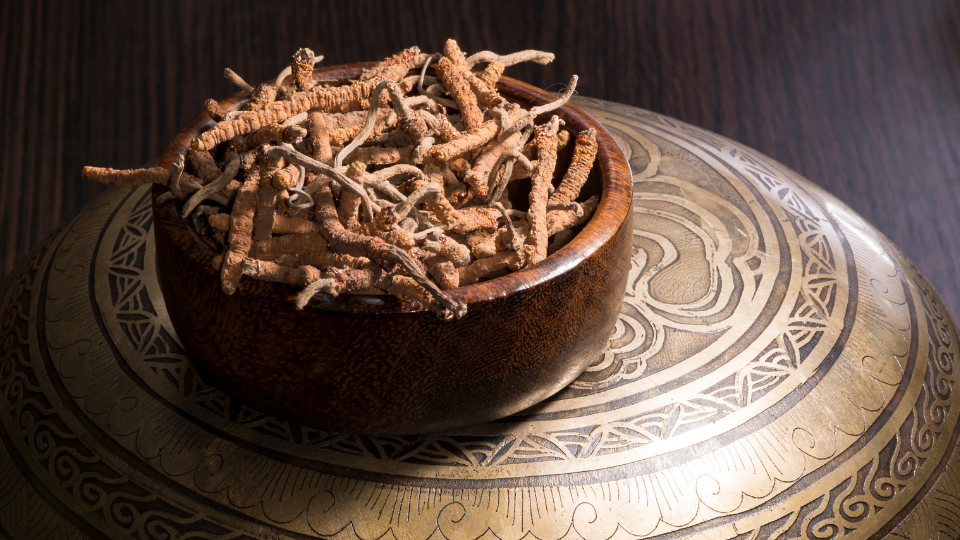
Using Cordyceps for health is nothing new.
Cordyceps sinensis was officially recorded as an herbal drug in China in 1964, but its history may go back as much as 1,500 years!
The very first reference to cordyceps as a medicinal mushroom appeared in the year 101. Other records suggest it was in use in China as far back as 620, and it made an appearance in the Essentials of Materia Medica in 1694. In 1757, the first scientific description was included in the New Complication of Materia Medica, and the mushroom was finally dubbed Cordyceps sinensis in 1878 by Saccardo, an Italian scholar.
What made the mushroom so popular as part of Chinese medicine? It was believed to possess properties that could “replenish the kidney, soothe the lung, stop bleeding, and eliminate phlegm.*”[6]
Cordyceps also has a history of use in the Indian state of Sikkim as an aphrodisiac, as well as for numerous diseases and ailments, including*:[7]
- Poor appetite*
- Cancer*
- Fatigue*
- Chronic pain*
- Tuberculosis*
- Liver & kidney diseases*
The mushroom has been used alone and in combination with other herbs in traditional preparations to produce the desired effects.
Cordyceps didn’t start gaining popularity with the general public until around 1995. The increasing interest in its potential benefits has led to issues with overharvesting—and some pretty hefty price tags.
How Cordyceps Works (It’s Scientific!)

Cordyceps is often used for energy and endurance.
What causes the effects for which cordyceps mushrooms are so celebrated? Several active compounds work together to influence numerous systems and processes throughout the body.
Polysaccharides, including beta-glucans, are found both inside and outside the cells of cordyceps and make up 3% to 8% of the mushroom’s weight.[8] These complex carbohydrate chains are actually strings of smaller carbohydrate molecules; in cordyceps, these include the monosaccharides mannose, glucose and galactose.[9] Numerous polysaccharides have been extracted from these mushrooms and tested for their specific benefits.
Nuceloside analogues are a unique component of cordyceps. These molecules contain a nucleic acid analog, a sugar and a phosphate group made up of one to three phosphates.[10] Why is this important? True nucleosides are found in DNA and RNA. The analogs in cordyceps have a different structure but function similarly,[11] which can affect processes involving DNA replication.
The most notable nucleoside analog in cordyceps is called cordycepin, or 3-deoxyadenosine, the highest concentrations of which are found in C. militaris fruiting bodies.
Other notable cordyceps mushroom compounds include:
- Lipids (fats), including unsaturated fatty acids and sterols[12]
- Amino acids, the building blocks of proteins, including ring-shaped chains known as cyclic peptides and pairs of amino acids called polyamines[13]
- Antioxidants like carotenoids and superoxide dismutase (SOD)[14]
- Cordycepic acid, or d-mannitol
From a nutritional standpoint, cordyceps is a source of a range of vitamins and minerals, which is pretty common among both medicinal and culinary mushrooms!
What Are the Benefits of Cordyceps Mushroom?
Cordyceps’ active compounds have been studied both in isolation and as a complete package, usually in animal (in vivo) or cell (in vitro) studies. The results don’t necessarily mean that cordyceps has the same effects in humans, but these studies do provide insight into how the mushroom’s active compounds interact with the body.
By examining the way the active compounds behave in lab environments, scientists get an idea of the potential reasons behind why cordyceps has been prized as a medicine—and how the mushroom could best be used to address illness in humans.
Here are 14 ways Cordyceps might improve health, according to science.
1) Makes the Immune System Stronger*
Beta-glucans are the most notable polysaccharides found in medicinal mushrooms and are often cited for their ability to balance and support immune function*. The beta-glucan concentration in cordyceps is likely a factor in the numerous effects the mushroom has on the immune system*.
The interesting thing is that cordyceps isn’t necessarily an immune “booster;” rather, it’s known as a bidirectional modulator because it either stimulates or suppresses immune responses depending on what the body needs*. This effect works on both types of immunity to give the body extra ammo for immediate defense against infections (innate immunity) and provide support for more targeted responses (adaptive immunity)*.[15]
This balancing act involves several related processes:
- Increased production of pro- and anti-inflammatory cytokines, including tumor necrosis factor alpha (TNF-alpha)*
- Increased production of nitric oxide, which is toxic to bacteria*[16]
- Macrophage activation, which increases the body’s ability to get rid of pathogens*
- Stimulation of phagocytosis—the engulfing and destruction of pathogens*[17]
- Enhancement of natural killer (NK) cell activity*
Together, these effects of cordyceps may increase the body’s ability to kill invading bacteria and viruses or destroy and remove damaged cells*.
How does it work? Cordyceps mushroom appears to influence signaling between immune cells in a way that promotes appropriate immune responses and tamps down excessive inflammatory reactions*.
It also helps with the maturation of dendritic cells, the cells responsible for presenting foreign substances—called antigens—to the immune system so that the body can decide whether a defense is necessary*.
Cordyceps also may improve the health and function of the kidneys, spleen and thymus, all of which are key players in immunity*. The thymus is particularly important—it’s where T-cells, one of two primary types of immune cells, go to mature after being produced in the bone marrow.
Cordyceps and Gut Immunity
Special immune tissue in the gastrointestinal tract, known as gut-associated lymphoid tissue (GALT), could play a role in how cordyceps regulates immunity*. A study on chicks showed hot water extract from C. sinensis improved the balance between harmful and beneficial bacteria in the gut, which may improve gut-related immunity*.[18]
Cordyceps also appears to:
- Stimulate macrophages in GALT to promote antibacterial action*
- Increase the release of immunoglobulin A (IgA), which improves gut immune defense*[19]
- Reduce inflammation by eliminating antigens*
2) May Boost Athletic Performance*
In 1993, the Chinese Olympic women’s track and field team stunned the watching world by breaking multiple records—and attributed their success, at least in part, to supplementing with cordyceps. Since then, the mushroom has enjoyed a popular reputation as a performance booster.
Animal studies show that the mushroom does, in fact, appear to increase endurance*. It may also increase oxygen capacity—the amount of oxygen the blood can absorb—which in turn has the potential to improve muscle function and endurance*.[20]
In one study, mice treated with C. militaris polysaccharides were able to swim longer without fatiguing*. This may have been due to a reduction in byproducts like lactic acid and an increase in serum levels of antioxidants. Glycogen concentrations in both the liver and muscles also increased, suggesting the mice had more fuel available to power their swimming.[21]
Similar results were seen in rats given an O. sinensis supplement: Compared to control groups, the rats receiving cordyceps exhibited a greater increase in endurance when swimming. The mushroom appeared to increase the level of metabolic regulators in skeletal muscle, which helped the muscles use more glucose and lactate as fuel for exercise. Researchers also noted increased development of muscle capillaries, which could allow more oxygen to reach muscle tissue.[22]
Does Cordyceps Increase Athletic Performance in Humans?
Some small human studies appear to support cordyceps’ performance-enhancing effects:
- A study of 20 healthy people ages 50 to 75 showed taking a Cs-4 supplement three times a day for 12 weeks increased the amount of time it took for lactic acid to build up in the muscles and allowed participants to exert themselves more before getting out of breath. However, there was no effect on the maximum amount of oxygen their bodies could use during exercise, known as VO2 max.[23]
- Another study suggests VO2 max may be improved by supplementing for more than three weeks, allowing for better oxygen use and therefore more endurance.[24]
- Supplementing with cordyceps appears to improve energy output in sedentary and/or elderly people but not in high-performing endurance athletes, which could mean the mushroom has more potential for people who haven’t yet achieved peak performance*.[25,26]
Why does cordyceps provide an exercise boost?
It appears to work in several ways, including increasing energy, reducing exercise byproducts, increasing availability of oxygen and fuel and reducing inflammation through increased antioxidant capacity*.
3) may reduce Inflammation*
Cordycepin and other compounds in cordyceps mushrooms exhibit anti-inflammatory properties when tested on cells in vitro*:
- Human blood cells treated with extracts of Cordyceps had lower natural killer cell activity and produced less of the pro-inflammatory cytokine interleukin-2 (IL-2)*.[27] The extract also reduced production of TNF-alpha, a protein called a cytokine that acts as one of the main regulators of the inflammatory response*.[28] This beneficial immunosuppression could have powerful implications for addressing a number of conditions in which inflammation is a key factor*.
- In a model of inflammation induced in macrophages, Cs-4 reduced numerous compounds associated with the inflammatory response, including nitric oxide and pro-inflammatory cytokines*. It appeared to work by inhibiting nuclear factor kappa beta (NFk-B), which is involved in cytokine production, and AP-1,[29] which can control genetic expression in response to cytokines, stress and infections*.[30]
Cordcyeps’ anti-inflammatory effect is one of the reasons this mushroom is beneficial for immunity*. Reducing inflammation helps restore balance in the immune system, allowing for more effective and appropriate responses to pathogens*. Less inflammation can also mean less pain, making cordyceps a potential option for pain relief*.[31]
Antioxidants
Oxidative stress can cause cell damage that contributes to inflammation, but cordyceps shows promise as an antioxidant*. Extracts are not only able to reduce the presence of the free radicals that cause oxidative damage but may also prevent cholesterol from oxidizing, which is the first thing that happens when plaques form in blood vessels*.
Polysaccharides and polyphenols in cordyceps seem to exhibit the most antioxidant power. The strength of the response to oxidative stress varies depending on the variety of cordyceps and the type of molecule*.
Anti-Aging
Both anti-inflammatory and antioxidant activity can slow the effects of aging, suggesting that cordyceps could be a good choice for promoting healthy longevity*. One study showed CS-4 can improve oxygen uptake, aerobic capacity and fatigue resistance in artificially aged mice*.[35]
But there was an additional benefit: improved memory and brain function*. The possible mechanism? A reduction in monoamine oxidase (MAO), which is responsible for breaking down the neurotransmitters brain cells use to communicate*.
4) Supports Heart Health*
Because both inflammation and oxidative stress are causal factors in heart disease, cordyceps has may be able to prevent several potential complications, including oxidation of LDL*.
Oxidized LDL prompts an immune response, which triggers a series of events that lead to plaque formation. Plaquing narrows blood vessels over time, reduces blood flow and increases the risk of heart attacks and strokes. The immunomodulating, anti-inflammatory and antioxidant benefits of cordyceps can work together to protect against all factors involved in plaque formation.
Cordycepin may offer additional anti-plaquing benefits by acting on specific adenosine receptors called A(1) and A(2)*.[37] When cordycepin interacts with these receptors, it appears to prevent cells in blood vessel walls from migrating and proliferating, which reduces scar tissue formation*.
Does Cordyceps Lower Cholesterol?
Several rodent studies suggest additional benefits of cordyceps for heart disease may come from the mushroom’s ability to improve cholesterol profiles:
- Hamsters and rats fed high-fat diets and treated with cordycepin for four weeks wound up with lower total cholesterol, triglycerides, LDL, VLDL, as well as better ratios of LDL to HDL and total cholesterol to HDL*. These effects may have been the result of an increase in lipases, which break down fats in the body*.[39]
- Another study of hamsters fed high-fat diets showed similar results along with a reduction in visceral abdominal fat*.[40] In this case, cordyceps may have worked by activating 5′-AMP-activated protein kinase (AMPK) and increasing phospho-acetyl-CoA carboxylase, both of which play roles in the way the body processes fatty acids*.
These benefits may not be universal, however, scientists studying the effects of O. sinensis hot water extracts in mice found that the animals on higher-cholesterol diets showed the greatest improvement in blood cholesterol levels,[41] so cordyceps may not have any significant effects when cholesterol intake or blood cholesterol is already low*.
5) Gives an Energetic ATP Boost*
One of the reasons cordyceps mushroom is associated with better athletic performance may be due to its unique enhancing effect on adenosine triphosphate (ATP)*.
ATP is the “energy currency” of the body. After food is broken down into simpler components, some of these molecules go through a complex cycle of chemical reactions called the Krebs cycle (high school biology, anyone?).
ATP produced during this cycle powers cells and builds up the body.
Because this process is so complex, it’s no surprise that the way cordyceps may boost ATP is also a bit complicated. Studies suggest the mushroom has a direct effect on how much ATP is generated, perhaps by increasing enzyme levels during the Krebs cycle*.[42,43]
These effects were shown in a study on mice given an extract from C. militaris fruiting bodies for two weeks. The mice had more ATP in both their livers and muscles than control mice, and they were able to recover better from fatigue*.
-So, rather than reducing muscle fatigue, cordyceps may improve endurance and energy by acting directly on the processes by which the body makes energy*.[45]
6) May Improve and Support Lung Health*
Practitioners of traditional Chinese medicine believed cordyceps mushrooms could clear excess phlegm, leading to better respiratory function*. Because of this, the mushroom has been used traditionally to address respiratory problems*.
Studies on inflammation, lung scarring and lung injury offer some support for this historical application. Both the anti-inflammatory and immunomodulating effects of cordyceps could have benefits for respiratory ailments involving inflammation and infection*.
In a mouse model of acute lung injury, which involves an acute inflammatory response, cordycepin appeared to prevent or block inflammation and reduce oxidative stress by regulating specific genes and proteins*.[46] Extracts from O. sinensis may also reduce the inflammatory immune response in this condition*.[47]
Cordyceps show promise for decreasing changes in tissue that can lead to scarring in lung fibrosis*.[48] It’s possible that cordycepin plays a role here. As an adenosine analog, it can interact with adenosine receptors in the lungs to potentially regulate inflammation to prevent scar tissue formation*.[49]
Cordyceps and Asthma
The effects of cordyceps on inflammation may be useful in addressing asthma*. A human trial investigated this potential by splitting 120 people into two groups. One group received C. Sinensis capsules for 3 months along with their regular asthma treatments as needed; the other group just used their regular treatments.
At the end of the study, the group that took cordyceps reported better quality of life, and their lung function had improved*. They also had fewer inflammatory markers and higher levels of immunoglobulin-G (IgG) levels, suggesting a more balanced immune response*.[50]
Polysaccharides from C. militaris appear to suppress pro-inflammatory compounds in a mouse model of asthma, including a very powerful cytokine called transforming growth factor beta 1 (TGF-β1)*. Cordyceps also reduced immunoglobulin-E (IgE), which can be elevated in asthma and is associated with allergic reactions*.[52] Water extracts of Cs-4 show similar anti-inflammatory activity and may reduce airway hypersensitivity associated with asthma*.[53]
7) Shows Promise for Fertility*
Both men and women can suffer from problems with infertility. According to the U.S. Centers for Disease Control and Prevention (CDC):
- 12% of women under 44 have a hard time getting pregnant or having a full-term pregnancy
- 6% of married women under age 44 struggle to get pregnant even after trying for a year
- About 8% of infertility cases among couples result from male infertility[55]
Although there are many potential causes, cordyceps may be able to address infertility resulting from hormonal imbalances*.
In vivo research shows O. sinensis can increase the most bioactive form of estrogen, 17beta-estradiol (E2)*. In premenopausal women, E2 regulates the female reproductive cycle, maintains egg health and prepares the uterus to nurture fertilized eggs, all of which are essential for a successful pregnancy*.[56] Cordyceps appears to regulate E2 by increasing steroidogenic acute regulatory protein (StAR) and aromatase, both of which are involved in the production and regulation of steroid hormones like estrogen*.[57]
For male fertility, C. militaris and cordycepin show some promise. “Subfertile boars” given C. militaris for two months produced more and healthier sperm*. These effects continued for two weeks after stopping treatment.[58] Middle-aged rats given cordycepin experienced similar results.[59]
As of yet, it’s unknown whether cordyceps supplements can offer the same benefits for human fertility*.
8) Improves Blood Flow*
In addition to reducing inflammation and preventing the formation of plaques inside blood vessels, cordyceps mushroom may also help blood vessels relax and open up by boosting both nitric oxide and endothelium-derived hyperpolarizing factors*.[60]
The result? Less pressure inside blood vessels and better overall blood flow*.
Does Cordyceps Really Works for Libido?
It’s a delicate question, but cordyceps has historically been seen as a solution for low libido, for which poor blood flow is only one of many potential causes*.
In fact, loss of libido can accompany or indicate other health problems, including heart disease, hormonal imbalances, depression, medication reactions, diabetes, reproductive disorders and drug abuse. Age is also a contributing factor.
In cases where hormones are the culprit, cordyceps may be able to help*. The mushroom apparently works by affecting the process the body uses to turn cholesterol into testosterone*.[61] C. sinensis and several of its isolated extracts were able to boost testosterone in both mouse cells and actual mice of various ages, indicating there could be some truth to the anecdotal stories linking cordyceps and libido*.[62,63]
9) may exhibit Anti-Diabetic Properties*
Compounds in cordyceps have shown promise as anti-hyperglycemic agents—that is, the mushroom could improve both glucose tolerance and glucose control, leading to lower blood sugar levels*.
When scientists treated diabetic rats with cordyceps fruiting body extract for four weeks, the animals gained less weight than the control group, and their bodies responded better to glucose*.[64] Rats given Cs-4 had lower levels of blood markers associated with excess insulin release, suggesting their cells were more sensitive to insulin and needed less of it to balance blood sugar levels*.[65,66]
Cordycepin’s similarity to adenosine may come into play here. Adenosine receptors are found throughout the body, and the nucleoside has an effect on insulin signaling in muscles, fat and the liver.[67] As a stand-in for adenosine, cordyceps may help regulate insulin activity*.
Adenosine is also important in regulating inflammation, immune response and oxidative stress. Because both fat and immune activation are pro-inflammatory, these combined effects could be of particular interest when diabetes is accompanied by obesity.
Chronic inflammation could have a negative effect on pancreatic function, which directly influences insulin production and release.[68,69] But C. militaris polysaccharides exhibit lipid-lowering effects in mouse models of diabetes, leading to less fat in the blood and less fat oxidation. Even in mice fed high-fat diets, the mushroom reduced insulin resistance, lowered blood sugar levels and reduced liver, kidney and pancreas injuries associated with diabetes*.[70]
10) may protect and Restore the Liver*
Liver fibrosis, or scarring of the liver, can interfere with liver function and cause complications that are fatal in some people. Cordyceps may be able to protect against scar tissue formation, known as fibrosis, and has been used to treat chronic hepatitis, as well as address the scarring that can result from the disease*.
Studies support this clinical application, C. sinensis has been shown to relieve induced liver fibrosis rats by increasing the activity of an enzyme involved in collagen breakdown, effectively preventing scar formation*.[71] In another study, cordyceps was able to not only prevent scarring but also reverse existing damage*.[72]
What gives cordyceps its anti-fibrotic benefits? Both cordycepic acid and cordycepin appear to inhibit the boost in collagen production associated with liver scarring to reduce fibrous tissue formation*.[73] Ergosterol may also be involved.[74]
Does Cordyceps Protect Against Fatty Liver?
In a study of 14 people, supplementing with Cordyceps for 90 days appeared to reduce liver enzyme levels twice as fast as simply abstaining from alcohol*.[75] C. militaris lowered total lipids and triglycerides in the livers of mice with non-alcoholic fatty liver disease, suggesting better liver function*.[76]
11) may improve kidney function*
Traditional healers may have been on to something when they turned to Cordyceps to address problems with kidney health*. A quick breakdown of the science shows:
- C. sinensis can reduce gene expression related to inflammation and cell death in kidney injuries caused by loss of blood flow, known as ischemia-reperfusion injuries*.[77]
- C. militaris may improve markers of kidney health while reducing enzyme activity associated with damage from kidney injuries, perhaps by prompting the body to make more of its own antioxidants*.[78]
- Both types of cordyceps mushrooms appear to interfere with the way LDL cholesterol can promote excessive growth of mesangial cells, which are found in the kidney’s filtering units*. This in turn can prevent LDL-related kidney injury or failure.[79]
12) May Have Calming Effects on Anxiety*
Like other medicinal mushrooms, cordyceps is an adaptogen, meaning it can have positive effects on hormones related to stress*. These hormones, including adrenaline and epinephrine, are produced by the adrenal glands in response to stress and regulated by both the hypothalamus and pituitary gland.
Cordyceps may be able to balance the stress response by affecting the way the hypothalamus and pituitary stimulate hormone release and helping the adrenal glands be more effective*.[80,81] This can improve stress tolerance and reduce fatigue, as well as increase tolerance for physical and mental fatigue when it does occur*.
Although most medicinal mushrooms share these properties, cordyceps appear to exert its benefits specifically by affecting nitric oxide production. Because nitric oxide increases in stressful situations, regulating its release could help the body react and recover more efficiently*.
Antioxidants may also have beneficial effects for people prone to high stress levels or anxiety. When people with anxiety disorders are given antioxidant nutrients, their condition appears to improve.[82] This hasn’t been directly tested with cordyceps yet, but it’s possible the mushroom could have similar effects due to its antioxidant properties*.[83]
13)could hinder virus Replication*
Cordycepin’s status as a nucleoside analog gives it a pretty cool superpower: Interfering with viral DNA and stop viruses from making copies of themselves*.
If this sounds super nerdy, that’s because it is.
The reason cordycepin is only similar and not identical to adenosine is because it lacks an oxygen atom in one part of the molecule. But it’s similar enough that it can replace adenosine during DNA replication and actually stop the process.
This is much less likely to happen in normal cells, so there’s little risk of cordyceps affecting healthy tissues*. But in cells weakened by viruses or cells that divide quickly, this mushroom may have the ability to prevent damage or stop infections from spreading*.
Nucleoside analogs have already been used this way to combat diseases like HIV and hepatitis via drugs called reverse transcriptase inhibitors. While these drugs don’t contain cordycepin, they have similar function, which makes cordyceps mushroom a good candidate for study in this area.
The general immunomodulating properties of cordyceps may also have an anti-viral effect, perhaps by boosting key immune compounds that help the body defend itself*.[84]
Choosing the Best Cordyceps Mushroom Supplement
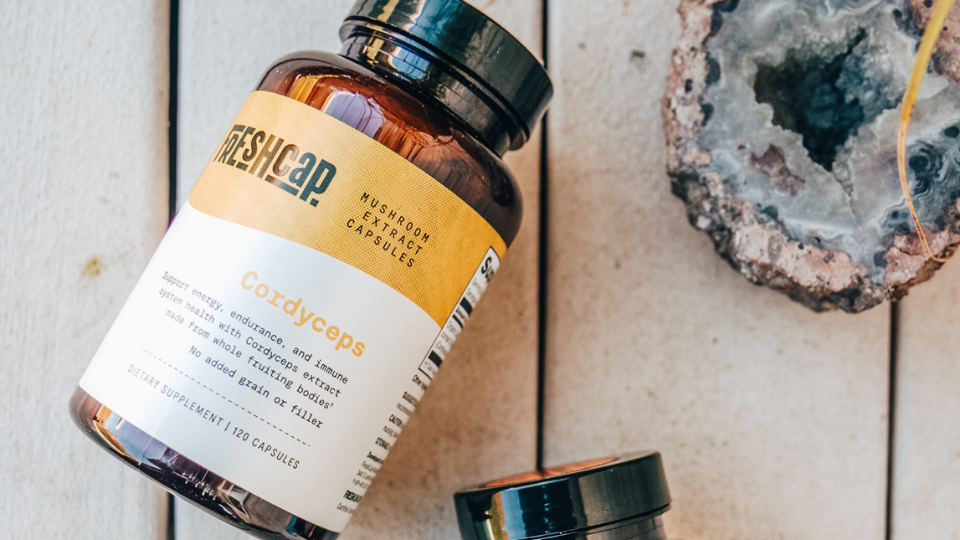
You can get Cordyceps in capsule or powder form.
Medicinal mushrooms are usually sold as pills, powders or liquid extract tinctures.
Dual-extracted supplements are considered the gold standard, but since many of the important compounds in cordyceps are water-soluble, water extracts can also provide powerful benefits.
Most cordyceps supplements contain C. militaris unless the label specifies Cs-4 mycelium was used. It’s incredibly rare to find a supplement made from wild-harvested O. sinensis; such supplements either carry huge price tags or don’t actually contain what they claim.
Why is Cordyceps So Expensive?
The weird (and slightly creepy) life cycle of wild cordyceps coupled with demand for its medicinal properties makes O. sinensis one of the priciest mushrooms in the world.
In 2007, the cost hovered around $25,000 for 1 kilogram, or about $11,365 per pound—and the highest-quality cordyceps can cost even more. These rare wild specimens are only found for sale in Asia. As prices continue to rise, researchers are looking into more options for cultivating the mushroom at scale.
Cordyceps Mycelium on Grain vs. Liquid Culture vs. Fruiting Body
To date, C. militaris is still the best option when growing cordyceps for supplements. It’s easy to produce full fruiting bodies that contain the best mix of beneficial compounds and a higher level of cordycepin than mycelium*.
The same compounds are found in Cs-4, but there’s a question as to how many compounds outside the mycelial cells are discarded along with the liquid culture used in production*.
Mycelium grown on grain and harvested without producing a fruiting body also contains active compounds, sometimes even at concentrations similar to those achieved by other growing methods. But because the cordyceps mycelium can’t easily be separated from the grain, high levels of grain-based starches dilute the final product.
How Supplements are Made from Cordyceps
Cordyceps mushrooms get turned into supplements one of two ways:
- Cultured Cs-4 mycelium is removed from the fermentation tanks, dried and turned into powder; no extraction process is necessary
- C. militaris fruiting bodies may be processed through water extraction or dual extraction before being spray-dried and turned in to powder
Both methods result in cordyceps supplements that contain polysaccharides, lipids, cordycepin and the range of other compounds that give the mushroom its health-promoting properties.
Cordyceps Supplement Red Flags
Unfortunately, not every medicinal mushroom product on the market is high quality—and quality is essential for good results. To get the greatest benefits from taking cordyceps:
- Avoid cheap products that claim to contain wild C. sinensis
- Check ingredient lists for any mention of grain
- Choose companies that can provide proof of the active compound content
You should also look for Cordyceps that is certified organic.
Where to Buy Cordyceps Mushroom
Cordyceps supplements are available online, as well as at some supplement and natural food stores. They can also be purchased directly from companies with solid reputations for quality and safety.
It’s best to avoid buying wild cordyceps online, no matter how tempting it might be. Verifying the source and safety is difficult, and even if it’s 100% legitimate, the same benefits are available from C. militaris without the risk of overharvesting.
FreshCap cordyceps powder and capsules are made from C. militaris fruiting bodies. Every product is tested to guarantee the levels of beta-glucans and cordycepin for best results.
How to Take Cordyceps Mushroom Supplements
Capsules are the easiest, most convenient way to power up with cordyceps since they can be taken as-is any time.
Tinctures are also convenient but may have a strong flavor if they contain alcohol.
The taste of cordyceps powder is relatively mild (although some find it strong), but it can be easily added to meals, dressings, sauces, smoothies and beverages without much effect on taste.
When to Take Cordyceps for Best Results
Because cordyceps is known for being energizing, it’s best to take it in the morning or before a workout. It can also be taken after a morning workout for more energy throughout the day.
For most, Cordyceps supplements aren’t generally a good idea before bed, although consistent supplementation may lead to better sleep and improved sleep rhythms*.
That being said, some do not get an acute energizing effect from Cordyceps, so it depends on your individual reaction.
Cordyceps Dosage
In human studies, the benefits of cordyceps mushrooms have been tested at doses of 1 to 3 grams per day.
Some recommendations suggest taking cordyceps supplements only one or two times per week to enjoy the benefits for immunity and overall health*.[94] However, the best results for both energy and specific health effects may be achieved by taking the mushroom every day.
As with any natural supplement, Cordyceps shouldn’t be used to treat a health condition or in conjunction with prescription medications without the advice of a doctor or other knowledgeable health professional.
Cordyceps Mushroom Side Effects to Know
Cordyceps supplements are generally considered safe and have few potential side effects. As with any natural supplement, there can be some who experience digestive discomfort, or other individual responses.
Does Cordyceps Interact with Medications?
It’s possible that the beneficial properties of cordyceps mushrooms can turn into problems if supplements are taken along with certain medications. For this reason, it is important to first check with a doctor or natural health care practitioner if taking Cordyceps along with other medications.
Can You Eat Cordyceps?
Although it’s not the most obvious choice for a culinary mushroom, Cordyceps militaris is, in fact, edible!
(But not like Cheetos. That would be weird.)
These mushrooms have an earthy flavor similar to that of other mushrooms and provide a burst of “umami” in soups and salads. Recipes may call for “cordyceps flower,” referring to the fruiting bodies of C. militaris, which are usually sold dried. As with supplements, it’s important to vet the source first to ensure it’s reputable. (Buying from a local mushroom grower is the best option!)
To cook with cordyceps, soak dried fruiting bodies in hot water to rehydrate, and cook according to recipe instructions. The soaking water can be added to the dish or saved to drink as tea.
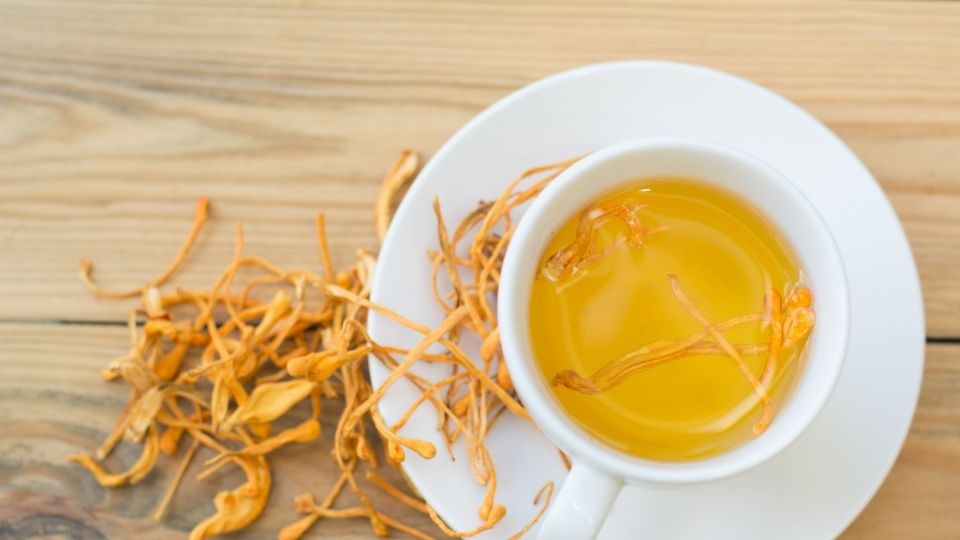
Brewing Cordyceps Tea
Dried C. militaris fruiting bodies can also be used primarily for tea and saved for use in recipes. To make a cup (or more):
- Measure out 4 to 5 grams of cordyceps per 8 ounces of water
- Bring the water to a boil
- Reduce the heat to a simmer and add the mushrooms
- Simmer for 15 minutes with the lid on the pan
- Strain out the fruiting bodies and set them aside
The resulting brew has a strong “mushroom-y” flavor; adding natural sweetener or a combination of ginger and lemon takes the edge off.
For a quicker tea, add 1/2 to 1 gram of cordyceps mushroom powder to 12 ounces of hot water. Sweeten or flavor as desired, stir and enjoy up to two cups per day.
Tasty Cordyceps Powder Recipes
Here are a few other creative ways to add the power of cordyceps to snacks and meals:
- Cordyceps Energy Bar
- Cordyceps Energy Balls
- Energy-Boosting Hero Smoothie
- Anti-Inflammatory Energy Smoothie
- Best Vegan Cheese Sauce (no one will know it has mushrooms)
- Mushroom Powered Macaroons
- Miso Mushroom Kale Chips (a true superfood treat!)
Cordyceps For the Win!
Behind its rather weird façade, cordyceps has a lot of power as a medicinal mushroom. The science to support some of its most famous effects is still in the early stages but shows a lot of promise. Its low incidence of side effects in most people makes it a safe option for improving immunity, boosting endurance and combatting fatigue*.
Taking a cordyceps supplement probably won’t turn you into a supercharged Olympian (although you can get there with practice). But making this mushroom a consistent part of your regimen can supercharge your routine!
